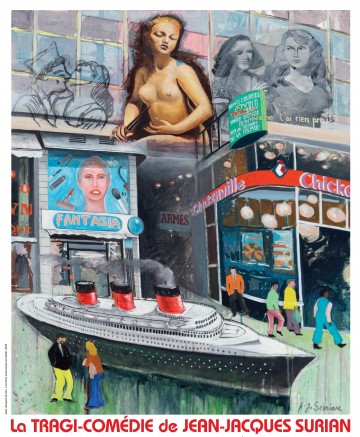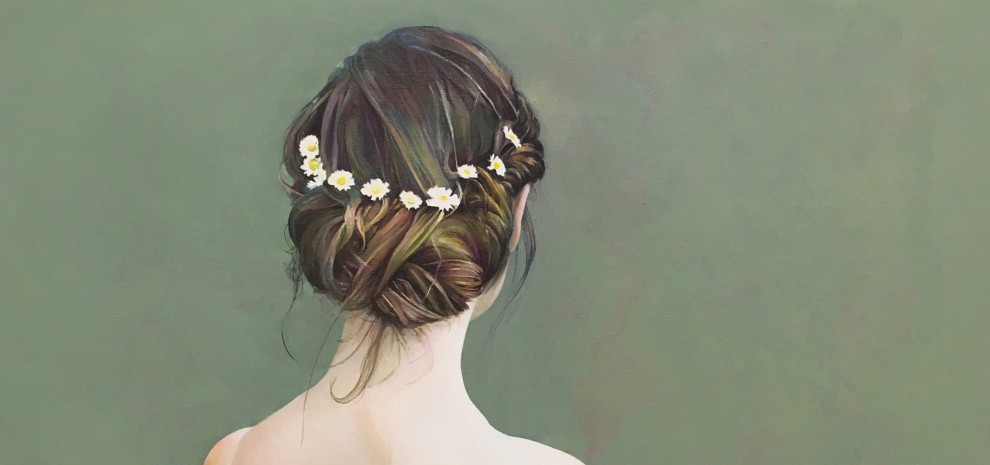
From October 18, 2024, to March 16, 2025, the Musée Regards de Provence presents the exhibition The Tragi-Comedy of Jean-Jacques Surian, highlighting the exuberant and symbolist work of the Marseille-based painter and ceramist, known for its roots in the southern, popular atmospheres of Marseille. Through a whirlwind of shapes, colors, and multiple references, Surian explores scenes from Marseille's everyday life and the adventures of picturesque characters, blending reality and fiction.
His work, deeply autobiographical and influenced by advertising, cinema, mythology, and major literary texts, is characterized by a jubilant and dreamlike approach to painting. His pieces, marked by a juxtaposition of whimsical figures and motifs, capture a kaleidoscope of familiar and unsettling images, blending sensuality, nostalgia, and a bittersweet critique of society.
The painter traverses the theater of life as the astonished witness of a society outside of time, as the narrator of a Dantean tragedy or a divine comedy that is nevertheless very real. Surian approaches and perceives human material with a destructive and jubilant voracity. His work is both dreamlike, fantastic, futuristic, polyvisionary, pantheistic, hypo-surrealist, and neo-expressionist.
It is pure sensuality, poetry, nostalgia, immediate enjoyment, visceral content, imagination, and boldly embraced fantasy. The artist says he “takes all the images that come to his mind” and juxtaposes them in a grand hallucinatory narrative, in a grand street theater teeming with anecdotes and characters from all social backgrounds.
The artist defends the idea that “art is a commitment of life with the freedom of creation.” Jean-Jacques Surian’s painting is the joy of painting, of living, and of having lived independently. His work is whimsical, fantastic, and dreamlike. His creations are deeply nourished by his personal biography, with references to advertising, comic books, toys, photography, masterpieces of art history, mythology, erotica, and stairs… The great foundational texts, from the Old Testament to the Divine Comedy, are also revisited in an expressive and symbolist palette. In his work, one feels a jubilation, a kind of pleasure in painting itself, which also emerges from a skillful blend of techniques: oil, ink, pencil, pastel, acrylic, and charcoal.
Jean-Jacques Surian becomes the wild chronicler of our youth in its historical, sociological, and emotional aspects in his series Psycho-Interiors, playing the role of the Painter-Imaginer. This chronicle is exuberant and jubilant, its interiors becoming places of visual celebrations in the kaleidoscope of our real or imagined memories. Surian captures, in brushstroke and stain, a sense of time rediscovered, made of mixed memories from the family apartment to various stages of his youth.
Surian includes numerous references to cinema, both formal and iconographic. The place of cinematic imagination in his work can be explored from at least three perspectives: the combination of reality and fiction, the sexualization of the female body, and the question of hierarchies in art, sometimes even staging his own family.
The theme of stairs constantly haunts Surian’s painting. Naturally, these are the stairs of Marseille — a city full of them, with its hills, heights, and even mountains extending to its very center. They are everywhere: the stairs of Notre Dame de la Garde, the Saint Charles train station, the Panier with the climb of the Accoules, the Cours Julien, the Roucas Blanc, Endoume, Palais Longchamp, Cours Lieutaud, with its passages, courtyards between buildings, and dead-ends that lead somewhere…
Surian is an ironist, a tender and lucid observer; he is funny and melancholic. His melancholy is that of time passing, of ages succeeding one another, of individual destinies with their humanity and absurdity, their procession of joys and sorrows, in a mix of cunning and naivety. However, this melancholy is somewhat graver, as Surian’s scenes can be dark, nocturnal, or bathed in a dying daylight — pale, gray, bluish, dark, sad, glowing — fantastic.
A catalog reproduces all 125 works presented, accompanied by texts and comments from Pierre Souchaud, painter, art critic, essayist; Yves Michaud, philosopher, former director of the École nationale supérieure des Beaux-arts de Paris, author; Marc Rosmini, philosopher, teacher, author; and Frédéric Valabrègue, writer, former professor of art history at the École nationale supérieure des Beaux-arts de Luminy, art critic (€30).
The Association and the Musée Regards de Provence thank the artist, his family, and the lenders for their participation: Collection Fabre-Maury, Collection Isabelle Vignoli Barthelemy, Collection Jacques and Marie Feat, Collection Joëlle and Jean-François Rey, Fondation Vincent van Gogh, Arles (Yolande Clergue Collection), Galerie Anna-Tschopp – Marseille, Musée Regards de Provence, Musée des Tapisseries – Aix-en-Provence, Musée d’art moderne – Céret, Collection RÉSO, Collection PÉBÉO, and private collections. They thank the Région Sud and the Département des Bouches-du-Rhône for their support, as well as the founding members who daily support the actions of Regards de Provence: Marseille Provence Airport, AG2R La Mondiale, Rothschild Martin Maurel Bank, Caisse d’Epargne CEPAC, CIC Lyonnaise de Banque, Les Terrasses du Port Shopping Center, Grand Port Maritime de Marseille, Sodexo, Prado Carénage Tunnel, Deloitte, Bleu Dixit, Fiducière de Provence, Grand Thorton, Indigo Group, Les Gavots de Provence, Marrou Traiteur, Payan Aménagement, ESI Fine Art, and RÉSO.
